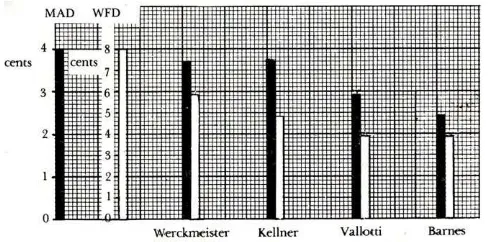ABSTRACT
In April 1979 Early Music 7/2 236-249 published John Barnes's seminal article “Bach's keyboard temperament: Internal evidence from the Well-Tempered Clavier”. Using statistical tools Barnes demonstrated the inadequacy of Werckmeister III, Kelletat and Kellner temperaments and proposed a new temperament that provides a very good fitting for the data.
In January 1980 EM 8/1 129 published a letter by C. Di Veroli showing that the case for Barnes's temperament was even stronger, and also that Vallotti's temperament ranked as 2nd best.
In January 1981 EM 9/1 141 published a letter by Herbert A. Kellner where he declared his belief in the superiority of his proposal and publications, and challenged C. Di Veroli to prove otherwise. Even before this letter was published, Early Music had already sent a copy to C. Di Veroli asking him to write a definitive paper.
In April 1981 EM 9/2 219-221 published C. Di Veroli's article: it demonstrates the optimality of Barnes's temperament compared with Werckmeister III, Vallotti and Kellner. It also proves that Kellner's work on his 'Bach' temperament, and also his refusal to accept Barnes's and Di Veroli's conclusions, are both fundamentally flawed.
EARLY MUSIC APRIL 1981 219 numbers). Numerology has shown that Bach was most skilful at writing his music with hidden numerical allusions. But to start with
coincidences and try to infer ‘facts’ is a
completely different matter. For instance, I was born in 1946, where 6-4 = 2 (numbers of keyboards on my harpsichord) , 1+6 = 7 (degrees of the diatonic scale), 9-4 = 4+1 = 5 (number of
8 = 9-1. This is neither magical coincidence nor dazzling numerical virtuosity on my part, but just a trivial amusement based on an elementary mathematical fact: starting from a set of integer numbers, almost any other set of small integers can easily be obtained by simple arithmetical operations. The above coincidences are also produced by the years 1947, 1948, 1951, 1952,
temperament in the English Harpsichord Magazine (ii/2 (1978), pp.32-6; ii/6 (1980), pp.137-40). The first article consists of three
pages of numerology plus a Conclusion: ‘. . .
tuning, and the rigour inherent in the methods of musicological research, all of what has been said here provides of course no proof whatsoever . . . nothing more than some rather obvious mathematical allusions . . .’. Oh surprise! He
knows numerology is not a valid research method! But the most incredible assertion comes
a few lines afterwards: ‘. . . it appears unlikely
that anything different could be drawn up to perform, with 12 fixed pitches per octave,
keyboard music through all 24 tonalities.’ Does
Dr Kellner really not know that descriptions of circular temperaments were already printed in 1511? What about the scores of circular temperaments by Werckmeister, Neidhardt et.
al.? Where is then the ‘uniqueness’ claimed by
Dr Kellner in his letter?
What I find most irritating is the fact that Dr Kellner has obviously not bothered to read Mr
Barnes’s article (EM 7/2, pp.236-49), where it is
scientifically proved that Dr Kellner’s ‘Bach’
temperament is not the best suited for Bach’s WTC. In view of these hard facts, I thank Dr Kellner for his kind invitation to disprove his claim, but I cannot possibly accept: it has already been done by others. Neither can I understand
why Dr Kellner should ‘improve his proposal’.
Since Mr Barnes has already improved it, and proved the improvement, from now on one
should try to improve on Barnes’s proposal
instead.
The above has not much to do with my letter,
where I said that Vallotti’s temperament was
EARLY MUSIC APRIL 1981 221
Hence, I may be expected to prove this assertion.
I will do it briefly, following Barnes’s criterion, based on what was obviously Bach’s aim: to use
the dissonant intervals less frequently than the consonant ones, in agreement with
Werckmeister’s ideas (1691). However, if
frequency and prominence of major 3rds is to be inversely related to deviation (mistuning), then the proper fit is not given by a direct proportion curve (a straight line, as used by Barnes) but by an inverse proportion curve (an hyperbola or, more generally, a power curve). Further, I have preferred to plot frequency against dissonance,
so that deviations with respect to the ‘best-fitting
power curve’ can be measured in terms of tuning
accuracy, rather than frequency of occurrence. As a measure of goodness of fit I use the mean absolute deviation (MAD), i.e. the average vertical distance from each point to the curve. Table 1 shows the plots produced by the temperaments of Werckmeister, Vallotti, Kellner and Barnes. We should also consider the mistuning of the 5ths, which in Werckmeister is very noticeable. Let us then compare the four temperaments by plotting together both their MAD and their WFD (worst-5th deviation), as shown in table 2:
Conclusion: J. S. Bach is much more likely to
have used a temperament like Barnes’s or Vallotti’s than one like Werckmeister’s or Kellner’s. I must admit however that the
differences are hardly noticeable in performance,
except for Werckmeister’s very obviously flat
